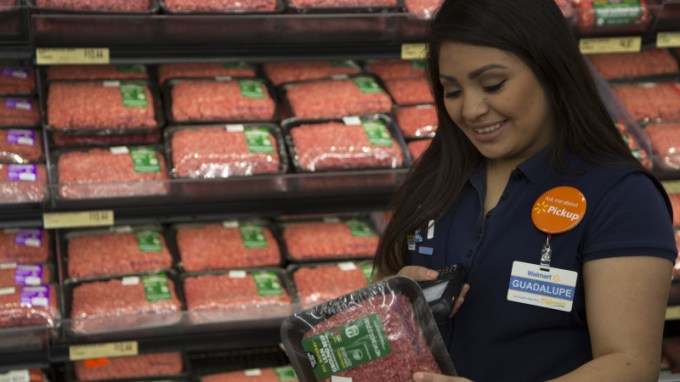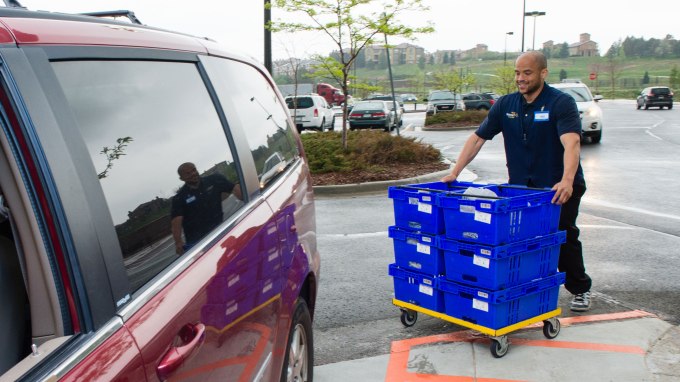Walmart announced on Wednesday a new last-mile delivery pilot program, called Spark Delivery, which focuses on fulfilling customers’ online grocery orders. The retailer is working with delivery logistics platform Bringg, a company that offers an Uber-like or Amazon-like level of visibility to retailers’ delivery operations.
Also similar to Uber, Walmart’s Spark delivery program relies on a crowdsourced workforce. That is, drivers will sign up for windows of time when they’re available to deliver groceries, and will then be provided with the order details and navigational assistance during their shift.
Bringg, fresh off its $12 million Series B earlier this year, tells TechCrunch it’s helping Walmart by offering the retailer the ability to optimize driver schedules, automatically dispatch orders, and allow drivers to communicate their availability. It will also send drivers smart alerts to ensure they don’t miss deliveries.
“By automating key parts of Spark’s dispatcher, driver and customer components, Bringg helps the service operate at optimal efficiency by enabling it to manage the fleet at scale, quickly on-board drivers, offer real-time visibility to everyone involved, and create seamless customer delivery experiences,” a company spokesperson noted.

Walmart is also working with Delivery Drivers, Inc. (DDI) to handle the administration of driver management, which includes the recruiting process, screening and background checks, payments, accounting, and other services.
The retailer didn’t say how much drivers would be paid, but noted it was “by the delivery.”
Customers pay $9.95 per delivery and must order a minimum of $30. But unlike with Amazon Prime/Prime Now, there’s no annual subscription required. Unlike Instacart, there aren’t price markups.
Grocery delivery is already available at Walmart in 50 markets, through other third-party partnerships like those with Postmates, Deliv and DoorDash (though no longer Uber and Lyft). That includes cities like Atlanta, Chicago, Denver, Miami and Seattle. The company in July had said grocery delivery was then live in 30 markets, and was on track to reach 100 metros by year-end.
Spark Delivery won’t impact those other relationships at this time, Walmart now says, noting its work with third-party delivery providers “continues to be a leading part of delivery strategy and important to the future.”
Instead, Spark Delivery will help Walmart reach its goal of 100 markets this year – which covers 40% of U.S. households, it says.
Walmart’s new Spark Delivery is currently being piloted in Nashville and New Orleans, before rolling out to other cities this year.
“Our customers love Grocery Pickup and Delivery – it offers convenience paired with the everyday low prices customers expect from us,” said Tom Ward, vice president, Digital Operations, Walmart U.S., in a statement. “We’re always looking for the best ways to serve them, so we’re exploring a number of different options for getting groceries from our stores to the customer’s front door – some in-house, some third-party.”

Crowdsourced delivery isn’t unique to Walmart. Many retailers and online grocery delivery services rely on contractor workforces, including Shipt, Postmates, Instacart, and Amazon’s Flex – the latter, which is focused on parcel delivery, not food.
However, Amazon does offer grocery delivery via Prime Now as well as AmazonFresh. It’s also one year into its acquisition of Whole Foods, which has seen it revamp stores with big coolers to house customers’ orders, roll out savings to Prime members, and even stock its hardware devices in some locations. But on the flip side, Amazon has been criticized for contributing to the declining quality of some Whole Foods items, like produce, and Whole Foods’ out-of-stock issues.
Amazon also last month launched grocery pickup service at select Whole Foods, with plans to expand it to more stores in the months ahead. The move was a direct response to Walmart, which has been steadily rolling out grocery pickup for years, and expects to offer it at over 2,000 stores by year-end. (In August, Walmart said grocery pick would reach 2,200 stores this year, but in this week’s announcement, that number was adjusted to 2,100.)
from TechCrunch https://ift.tt/2oLsSyI

No comments:
Post a Comment